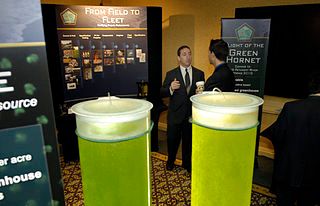A Young Person's Work with Algae as Biofuel
A friend asked my opinion on this high school kid’s experimentation with algae as biofuel.
Friend: Hmmm.
Craig: Well, this IS exactly what algae researchers are doing… And it DOES have promise, IMO.
Friend: It certainly would give us a much more carbon neutral solution for the existing transportation infrastructure – and, effectively, it’s solar energy. 🙂
Craig: You’re absolutely right. As long as we’re married to liquid fuels, there’s a lot to like here, including the fact that algae can be grown on non-arable land with salt water, and it’s 30 – 50 times more energy-dense that ANY terrestrial plant.
The problem is that it’s really hard to grow outside of carefully controlled laboratory conditions. If this is going to work, it’s going to take a lot of time and money, and a lot of that money is going to have to come from the public sector, since the private sector is so focused on short-term ROI.
The other issue is competition from electric transportation charged from wind and solar; i.e., we won’t be married to liquid fuels forever.
Btw, what an impressive young lady she is!


Most work with algae so far has concentrated on micro-algae which in some cases can have an oil content up to around 60% which is potentially very attractive for conversion to bio-diesel.
There is however the possibility of cultivating macro-algae otherwise known as seaweed for the production of ethanol or other alcohol fuels such as butanol.
Macro algae are very much easier to handle and manage than micro-algae and can be cultivated in tanks designed to aerate the water so that the seaweed circulates up and down like in a convection current rather than having to circulate it around a “race track tank” as is needed for micro-algae.
Alternatively, seaweeds can be grown at sea attached to ropes suspended from rafts and used to generate supplementary income for fishing communities. This form of cultivation is quite popular in the Philippines and Indonesia – primarily serving the Chinese and Japanese markets for edible seaweed.
When you need to harvest macro-algae it is possible to simply pull the seaweed up out of the tank – manually if necessary and transfer it for processing.
Much of the revenue of such a cultivation system can come from non-fuel products and services – the system can for example be used to remove phosphates and other fertiliser from agricultural drainage in a controlled way rather than have the phosphates trigger an algal bloom followed by die back as conditions in a river or lake become anaerobic. Algae can also remove some heavy metals including radio-active elements from contaminated water. Such environmental clean up can form the basis of a valuable paid for service.
When the certain seaweeds are grown in clean conditions, they can be dried and used as food, or processed for extraction of food supplements with the latter being compatible with using the seaweed for the production of fuel.
Hi Gary,
Can you point me to good data on efficiency and tradeoffs with regard to seaweed conversion to alcohol fuel? Anyone you know of doing it?
Cameron
I attended a conference in The Netherlands where one of the speakers was from NoriTech an Israeli company cultivating seaweed on land primarily with the Sushi market in mind, however they did consider using the seaweed for fuel production and were if I remember rightly achieving around 40 dry tons per hectare with their cultivation system.
http://israel21c.org/health/israeli-startup-extracts-sushis-health-potential/
Bio-Architecture Lab has recently isolated an enxyme to break down alginate – a sugar which makes up more than half the 60% sugar content of dried seaweed. They estimate that seaweed cultivation could yield 19,000 litres of ethanol per hectare per year.
http://au.ibtimes.com/articles/288304/20120127/seaweed-ethanol-breakthrough.htm#.UWATaKKsiSo